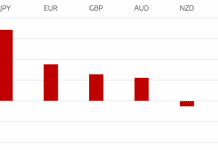One of the main differences between hedge funds and mutual funds is the amount – and in many cases the calibre – of active management that goes into them. For example, some mutual funds, such as index funds that simply invest equally in all the companies listed in a major stock index, have little or no input from a fund manager once they are set up. Funds such as these are very low-cost, with only an annual administrative fee to pay.
The more manpower is required to manage a fund, the more expensive it tends to be. In the case of hedge funds, the goal of absolute returns demands a very active management style, and in order to be successful you need to have very skilful traders running the show. Naturally, these guys don’t come cheap, which is why hedge fund fees are usually a fair bit higher than those of mutual funds.
Hedge fund fees fall into two categories – a management fee, and a performance fee. These are often expressed as a pair, with one of the most common being “two and twenty”. This amounts to an annual charge of two percent of the total assets in the fund (the management fee) and a performance fee of twenty percent of the profits above a certain base threshold or “hurdle rate”.
Management Fees
The concept of a management fee as a percentage of assets (regardless of returns) has been around since the very first hedge funds. These fees are usually charged annually as a percentage of the net value of the fund, but in most cases don’t change over time. They are commonly somewhere between one and four percent, and are paid in quarterly instalments to the fund manager.
In the case of smaller funds, this percentage may be determined by attempting to cover the operating costs involved in the management of the fund. On the other hand, larger funds may have higher management fees so that they can afford to attract the best fund managers and keep them.
Performance Fees
As well as management fees, hedge fund managers are usually paid a performance fee, which is calculated as a percentage of the profits made by the fund under their management. A benchmark figure for this is around 20% of the increase in the fund’s value over a specified period of time, such as a year, although some of the bigger fund management companies have been known to charge as much as 40%.
While fund managers are rewarded with performance incentive fees based on net value gains, they are not penalized for losses. To compensate for this, hedge funds often put in place limiting measures such as hurdle rates and high water marks in order to make them more attractive to investors.
High Water Marks
A high water mark is an aspect of the performance fee that specifies that the fund manager will only receive a percentage of the profits if the net value of the fund is higher than the previous highest value that the fund has achieved. Before it can charge an incentive, a fund is required to make up for previous losses. So, if you had a $1m fund that lost 50% in the first year, leaving $500,000, and it earns 100% profit the following year to take it back to $1m, it is not allowed to charge a performance fee on those profits because the investment is only back to where it was in the first place.
Opinions vary as to the effect of a high water mark, with some investors fearing that it will encourage the fund manager to take on unnecessary risk in order to chase losses. Other investors, on the other hand, see it as being an essential prerequisite for their investing in the fund.
Hurdle Rates
Another determining factor for hedge fund performance fees are hurdle rates, which are also referred to as minimum acceptable rates of return. These measure the performance of the fund against an external benchmark, and when they are applied, the fund manager will receive no performance fee percentages unless the rate of return meets or exceeds this rate. These rates can either be static and pre-determined or dynamic, moving in tandem with the rate of return from a finance industry benchmark, such as on US treasury bills or other fixed-income securities. By giving a guarantee that performance fees will not be charged in certain circumstances, funds reassure their investors that they will be compensated to a certain extent if the fund underperforms other investment options.
Withdrawal Fees / Lock-Up Periods
As well as charging management fees and performance fees, some hedge funds also charge a fee for withdrawing funds from the fund, known as a withdrawal fee. These are usually tied in to a certain time period, for example they might only apply for a set number of years after the initial investment. They might also apply to withdrawals above a certain amount, usually expressed as a percentage of the investment. The aim of withdrawal fees is to discourage investors from making casual withdrawals from the fund assets, as this enables fund managers to employ longer-term strategies with a greater degree of confidence. Another approach to this issue is to have a lock-up period, which is the minimum amount of time that has to pass after the initial investment before the investor is allowed to withdraw any funds.
I am a writer based in London, specialising in finance, trading, investment, and forex. Aside from the articles and content I write for IntelligentHQ, I also write for euroinvestor.com, and I have also written educational trading and investment guides for various websites including tradingquarter.com. Before specialising in finance, I worked as a writer for various digital marketing firms, specialising in online SEO-friendly content. I grew up in Aberdeen, Scotland, and I have an MA in English Literature from the University of Glasgow and I am a lead musician in a band. You can find me on twitter @pmilne100.










































